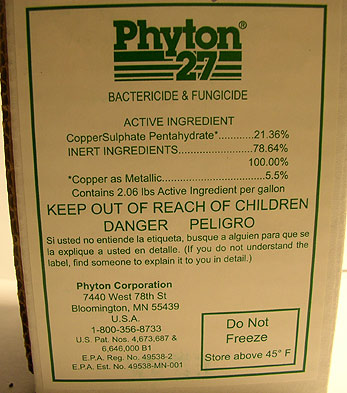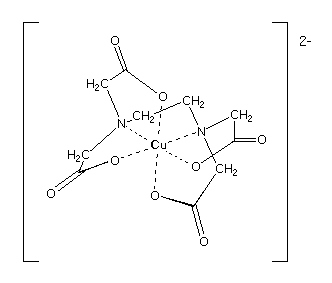(Состав, указанный на упаковке: "
CopperSulphate Pentahydrate 21,36%,
Inert ingredients 78,64%" - в переводе на более привычные названия: "Меди
сульфат пятиводный (
медный купорос) 21,36%,
инертные ингредиенты
78,64%".
- Сначала меня возмутила ...недобросовестность продавцов, бесстыже впаривающих обычный
медный купорос с таким фантастическим описанием - но потом понял, что не всё так
просто, и зря спешу с обвинениями.
Во вторых, искажение истины если и присутствует, то прежде всего заключается в другом - в указании состава этого "чудо-препарата" - именно "инертные наполнители" придают ему особые свойства.
- Это сложный комплекс из многих
компонентов:
"is a tannate complex
of picro cupric ammonium formate in aqueous solution combined with a minor
amount of a surfactant sufficient"
- Ионы меди, аммония, муравьиная кислота, пикриновая кислота (позднее от нее отказались - lnk),
галлодубильная кислота - непросто разобраться в конечной
структуре этого сложного варева!
В Интернете описывались и результаты его испытаний - в т.ч. с успехом
лечили поражённые деревья инъекцией в ствол - из-за чего, как мне кажется,
Phyton-27 и записали в системные (к слову,
преусловутые "инертные компоненты" тоже (сами по себе) обладали лечебным
эффектом при вызванных микоплазмами и риккетсиями заболеваниях).
Но ведь деревья - это особый случай! Там и медный гвоздь в ствол тоже
лечебным действием обладает... работает и введение раствора медного купороса
через фитиль (положительный эффект во многом объясняется стимуляцией защитных
сил дерева).
Но очень сомнительно, чтобы
Phyton-27
обладал даже не системным, а хотя бы просто трансламинарным действием при
попадании на листья обычных растений - хотя автор изобретения и приводит весьма
интересные примеры, за все эти годы практической проверки (сужу по данным из
Интернета) этот препарат не завоевал мир в качестве уникального лечебного
средства при бактериозах (например, в этой работе (на англ.) [
резюме - в виде картинки-скриншота,
вся статья в виде Pdf-файла], сравнивается эффективность
Phyton-27'a и других веществ против "бактериального ожога", вызываемого
Erwinia - и никаких чудес)...
Думаю, для обычных растений Phyton-27
является лишь мягко действующим (по сравнению с бордосской жидкостью и т.п.)
поверхностным фунгицидом и бактерицидом (с некоторой активностью против
микоплазм и риккетсий). Хороший препарат, если не ждать от него обещанных рекламой чудес (вроде системного действия); только использовать его надо свежим, непромороженным (а то начнет "расслаиваться" - и тогда
ожогов не миновать)...
...А что касается аналогов... - с некоторой натяжкой (мол, тоже комплексы
меди с пониженной токсичностью) к ним можно отнести
картоцид (трикапролактам меди (II) дихлорид,
моногидрат -
lnk) и «МЕДНЫЙ ГУМАТ» (
lnk), содержащий хелатное соединение этилендиаминтетраацетат меди (Cu-EDTA)... Существует также множество патентных заявок на применение других органических комплексов меди в качестве фунгицидов/бактерицидов (например,
эта) - только неясно, завершились ли они созданием соответствующих препаратов для сельского хозяйства.
Состав Фитона-27 и способ приготовления (а также результаты испытаний)
подробно описаны на страничке
http://www.freepatentsonline.com/4673687.html
("PRODUCTION OF KT-19827" -
KT-19827 и получил
впоследствии название
Phyton 27).
Цитата:
"B. PRODUCTION OF KT-19827
The chemotherapeutic, KT-19827, is a tannate complex of picro cupric
ammonium formate in aqueous solution combined with a minor amount of a
surfactant sufficient to prevent separating out of the tannate complex. KT-19827
is a soluble complex and is also relatively non-toxic to animals and plants at
doses used to control bacterial and fungal plant diseases, and viral and
mycoplasma diseases also previously mentioned as controlled by KT-198.
Cupric ammonium formate CuNH 4 (HCOO) 2 is produced
when one mole of cupric sulphate is reacted with 2 moles of ammonium formate in
aqueous medium. Tannic acid addition to this results in formation of the tannate
complex, which is water soluble gradually dissociating into water insoluble
cupric tannate. It has been pointed out by studies of A. W. Davidson and Vernon
Holm (Journal of American Chemical Society 53:1350-1357, 1931) that the
solubility of cupric ammonium formate increases with excess addition of ammonium
formate up to 43.75 mole percent. There is no solid phase separating out, and on
slight warming a deep violet bluish solution is formed. A ternary system NH
4 CHO 2 --Cu(CHO 2 ) 2 --HCHO 2
is formed. While this resembles cupric ammoniate solution formed by
addition of excess of ammonia to cupric sulphate solution, the presence of the
formate in the complex makes it totally different.
The avidity of picric acid to form complexes with copper ammoniates is well
known. Joshi and Bhargava (Journal of Indian Chemical Society 40: 19-22, 1963;
Chemical Abstracts, 58: 13408 d, 1963) showed that when picric acid is added to
a cupric ammoniacal solution, an olive green precipitate is formed which by
spectrophotometric study showed that the picric acid copper ammoniate complex
had one part of Cu(NH 3 ) 4 ++ and 2 parts of picric acid.
N. P. Agafoshin (Chemical Abstracts 32: 72, 1938) reported that complex
compounds of picric acid with copper ammoniates are formed when aqueous
solutions of picric acid are added to NH 4 OH solution of Cu(OH)
2 . A precipitate of the complex is formed with the formula [(C
6 H 2 (NO 2 ) 2 O)] 2
-(CuNH 2 ) 4 .
A similar complex is formed when picric acid is reacted with cupric
ammonium formate solution. However, unlike cupric ammoniate solution, there is
no formation of precipitate, but a soluble complex.
The physical properties of the product also show the formation of the new
complex, KT-19827. Cupric sulphate has no melting point but decomposes at 560°
C. and above. Ammonium formate has a melting point of 116° C. When cupric
ammonium formate complex is produced and evaporated to dryness, a hard bluish
material is formed, which will not melt even when autoclaved at 120° C. After
the formation of the picrate complex of cupric ammonium formate, the product
melts at 60° C. and can be handled as a thick viscid liquid. Hence, the KT-19827
fungicide-bactericide can be constituted in any formulation. A water-soluble
tannate complex of picro-cupric ammonium formate is formed. The product is a
greenish-brown to olive-green material which on dissolving in water forms a pale
yellowish-brown solution with fungicidal and bactericidal properties.
The details for the production of KT-19827 are described below:
EXAMPLE B-1
20 grams of tannic acid is dissolved in 200 ccs of water to which 400 grams
of pure (technical grade) ammonium formate is added and the solution is warmed
up to 70° C. 400 grams of copper sulphate, pentahydrate, is powdered and added
and mixed thoroughly. 40 grams of sodium lauryl sulphate is added and thoroughly
mixed. 20 grams of picric acid is added, thoroughly mixed and dried in a vacuum
oven at 40° C. A pasty greenish-black water soluble mass is produced which can
be stored at room temperature for long periods. 250 grams of the KT-19827 thus
produced is weighed and titurated with 500 ccs of commercial non-phosphate
dishwashing detergent or propylene glycol. The whole mixture forms a viscid
mass, which can be disposed to containers in measured quantities for dilution
and use in the field".
- И т.д.



